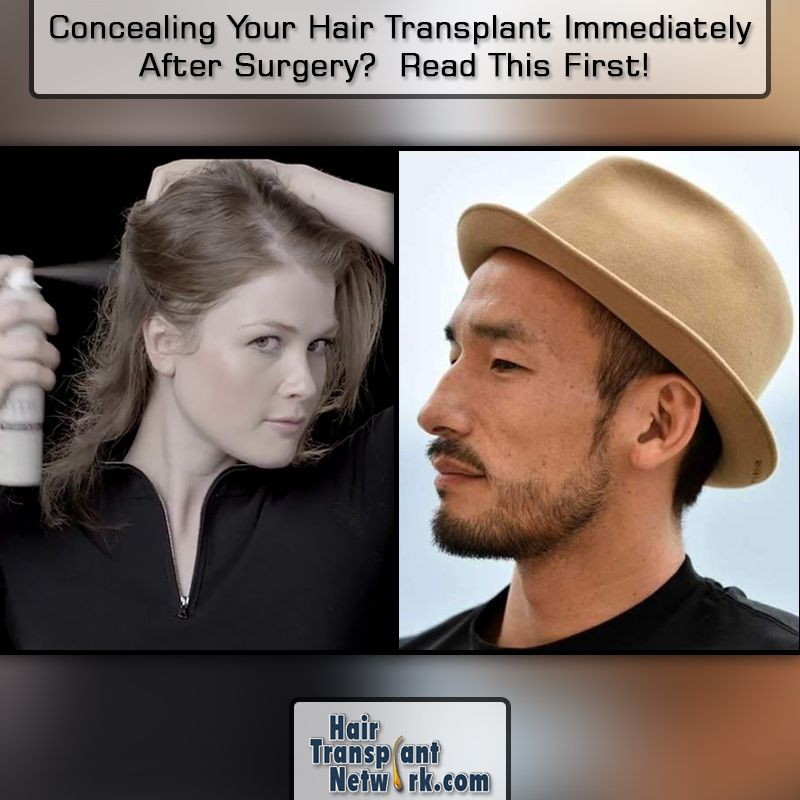Concealing Your Hair Transplant Immediately After Surgery? Read This First!

Male or Female hair loss is not so common today. However Getting a hair transplant is a personal
decision that some may want to keep a secret for some
reason or another, but even the most minor procedures do
carry some downtime. The majority of hair transplant
patients schedule their surgery around their vacation
time, so they don't have to appear at their workplace
for a few weeks. Unfortunately, hair transplant surgery
carries a negative stigma that prevents patients from
being upfront and honest about their procedure. In this
article, we will be discussing what to expect after a
hair transplant and how to conceal the procedure.
What To Expect After A
Hair Transplant
After a hair transplant the scalp is typically red/pink
with scabs forming around tiny graft incision sites. The
graft incision sites heal rapidly within seven to ten
days. The redness typically clears up and fades within a
few weeks of the procedure however, redness may persist
for a few months in some fair skinned individuals.
Unfortunately, persistent redness cannot always be
prevented, because redness signifies healing and some
minor inflammation of the skin which is normal after a
hair transplant.
Moreover, some patients may experience some hair
shedding commonly referred to as shock loss. Shock loss
which is a short-term form of hair loss that is caused
by stress, trauma or a surgical procedure, is described
as a chronic hair shedding which causes temporary
thinning. Fortunately, shock loss usually resolves on
its own after a few months, but the shock loss may be
difficult to conceal for some patients.
Conceal A Hair
Transplant with Hair Loss Concealers
In some cases, patients can request a hair transplant
surgeon to partially shave the recipient area, which
allows patients to style their hair in a way that
conceals the hair transplant recipient area.
Unfortunately, not every patient is in a position to
request a partial shave, because some patients may
require a large number of grafts. However, there are
still some products the patient may use to help them
conceal the signs of surgery.
The most popular hair loss concealers on the market
today are Toppik and DermMatch, these products help
boost visual density and conceal any hair loss. Toppik
is a magnetically charged hair fiber that attaches to
miniaturized thinning hair follicles, causing the hair
follicle to appear longer and fuller. DermMatch is a
hard-packed powder formula that matches the color of the
individuals hair and scalp, this provides an illusion of
fuller denser hair, because we see the scalp through
hair. In addition, DermMatch works well with short
buzzed hair, so even individuals forced to buzz their
head for their procedure can use the product.
Wear A Hat To Avoid UV
Rays
The old wives' tale about hats causing hair loss is not
true and that myth has been busted when examined with
real science. In fact, most hair transplant surgeons
recommend that patients wear hats and use sun block when
exposing themselves to powerful ultra violet (UV) rays
for the first four months. Today, wearing hats is
acceptable and actually stylish when paired with the
right clothing. Patients should wear loose fitted hats
for the first few weeks to ensure the grafts are not
damaged by tugging or scraping the grafts with the hat.
However, if an individual never wears hats and all of
the sudden starts wearing a hat every day, this may draw
unnecessary attention and prompt some people to start
asking questions. Therefore, anyone interested in
wearing a hat after receiving a hair transplant should
start wearing a hat a month before the procedure, so
that those around them get accustomed to seeing them
with a hat.
Conclusion
The majority of patients don't want to disclose that
they have had a hair transplant because of the negative
stigma associated with the procedure. However, being
upfront and honest with co-workers, friends and loved
ones highlights a real concern that men and women around
the world go through each day; that is hair loss.
Additionally, being honest can be very liberating and
with so many people suffering with androgenic alopecia
(genetic hair loss ) each day, being honest about
receiving a hair transplant may be enough to inspire
change in someone else's life.


